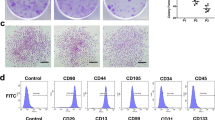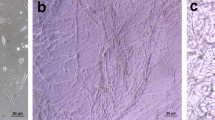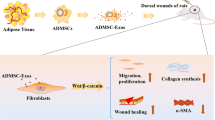Abstract
Fibroblast plays a key role in wound healing, and the advantages of mesenchymal stem cells (MSC) secretome in wound healing have previously been reported. In the present study, we investigated the impact of human bone marrow MSC-conditioned media (CM) on skin wound healing in diabetic rats and found that some improvements occurred mainly through fibroblast functions. Then, we scrutinized the impact of MSC-CM treatment on fibroblast cellular behavior by culturing human dermal fibroblasts (HDFs) in a high-glucose (HG) medium, as an in vitro diabetic model. In vivo findings revealed significant improvements in some healing kinetics of diabetic wound which received MSC-CM. Particularly, MSC-CM-treated diabetic wounds reached considerably higher percentages of wound closure. Also, the granulation tissue of these wound had less pronounced inflammatory response, better tissue remodeling, and more vascularization compared with non-treated diabetic ones. Gene expression analyses indicated that MSC-CM treatment leads to upregulation of epidermal growth factor (EGF) and basic fibroblast growth factor (bFGF) genes. In addition, a significantly higher cell viability/proliferation, migration, and bFGF gene expression were observed when MSC-CM was used to treat HDFs in HG culture media. Based on these findings, it is suggested that MSC-CM could promote wound repair and skin regeneration, in some major processes, via improvement of cellular behaviors of fibroblasts in the diabetic microenvironment. The beneficial advantages of mesenchymal stem cells-conditioned media on fibroblast cellular behaviors and wound healing may lead to establish a novel approach as an alternative therapeutic procedure to cure chronic wounds in diabetic conditions.




Similar content being viewed by others
References
Abdi R, Fiorina P, Adra CN, Atkinson M, Sayegh MH (2008) Immunomodulation by mesenchymal stem cells: a potential therapeutic strategy for type 1 diabetes. Diabetes 57:1759–1767
Amini A, Pouriran R, Abdollahifar M-A, Abbaszadeh HA, Ghoreishi SK, Chien S, Bayat M (2018) Stereological and molecular studies on the combined effects of photobiomodulation and human bone marrow mesenchymal stem cell conditioned medium on wound healing in diabetic rats. J Photochem Photobiol B 182:42–51
Ball SG, Shuttleworth CA, Kielty CM (2007) Mesenchymal stem cells and neovascularization: role of platelet-derived growth factor receptors. J Cell Mol Med 11:1012–1030
Baltzis D, Eleftheriadou I, Veves A (2014) Pathogenesis and treatment of impaired wound healing in diabetes mellitus: new insights. Adv Therapy 31:817–836
Bayat M, Chelcheraghi F, Piryaei A, Rakhshan M, Mohseniefar Z, Rezaie F, Bayat M, Shemshadi H, Sadeghi Y (2006) The effect of 30-day pretreatment with pentoxifylline on the survival of a random skin flap in the rat: an ultrastructural and biomechanical evaluation. Med Sci Monit 12:BR201–BR207
Brem H, Tomic-Canic M (2007) Cellular and molecular basis of wound healing in diabetes. J Clin Investig 117:1219–1222
Byl NN, McKenzie AL, West JM, Whitney JD, Hunt TK, Scheuenstuhl HA (1992) Low-dose ultrasound effects on wound healing: a controlled study with Yucatan pigs. Arch Phys Med Rehabil 73:656–664
Caplan AI, Dennis JE (2006) Mesenchymal stem cells as trophic mediators. J Cell Biochem 98:1076–1084
Chen L, Tredget EE, Wu PY, Wu Y (2008) Paracrine factors of mesenchymal stem cells recruit macrophages and endothelial lineage cells and enhance wound healing. PLoS ONE 3:e1886
de Mayo T, Conget P, Becerra-Bayona S, Sossa CL, Galvis V, Arango-Rodríguez ML (2017) The role of bone marrow mesenchymal stromal cell derivatives in skin wound healing in diabetic mice. PLoS ONE 12:e0177533
Dong L, Hao H, Liu J, Ti D, Tong C, Hou Q, Li M, Zheng J, Liu G, Fu X (2017) A Conditioned medium of umbilical cord mesenchymal stem cells overexpressing Wnt7a promotes wound repair and regeneration of hair follicles in mice. Stem Cells Int 2017:3738071
Ezquer M, Ezquer F, Ricca M, Allers C, Conget P (2011) Intravenous administration of multipotent stromal cells prevents the onset of non-alcoholic steatohepatitis in obese mice with metabolic syndrome. J Hepatol 55:1112–1120
Fahey TJ, Sadaty A, Jones WG, Barber A, Smoller B, Shires GT (1991) Diabetes impairs the late inflammatory response to wound healing. J Surg Res 50:308–313
Galiano RD, Tepper OM, Pelo CR, Bhatt KA, Callaghan M, Bastidas N, Bunting S, Steinmetz HG, Gurtner GC (2004) Topical vascular endothelial growth factor accelerates diabetic wound healing through increased angiogenesis and by mobilizing and recruiting bone marrow-derived cells. Am J Pathol 164:1935–1947
Geiger A, Walker A, Nissen E (2015) Human fibrocyte-derived exosomes accelerate wound healing in genetically diabetic mice. Biochem Biophys Res Commun 467:303–309
Hendudari F, Piryaei A, Hassani S-N, Darbandi H, Bayat M (2016) Combined effects of low-level laser therapy and human bone marrow mesenchymal stem cell conditioned medium on viability of human dermal fibroblasts cultured in a high-glucose medium. Lasers Med Sci 31:749–757
Jackson WM, Nesti LJ, Tuan RS (2012) Concise review: clinical translation of wound healing therapies based on mesenchymal stem cells. Stem Cells Transl Med 1:44–50
Kalluri R, Zeisberg M (2006) Fibroblasts in cancer. Nat Rev Cancer 6:392
Lerman OZ, Galiano RD, Armour M, Levine JP, Gurtner GC (2003) Cellular dysfunction in the diabetic fibroblast: impairment in migration, vascular endothelial growth factor production, and response to hypoxia. Am J Pathol 162:303–312
Li M, Zhao Y, Hao H, Dai H, Han Q, Tong C, Liu J, Han W, Fu X (2015) Mesenchymal stem cell-conditioned medium improves the proliferation and migration of keratinocytes in a diabetes-like microenvironment. Int J Low Extrem Wounds 14:73–86
Li X, Xie X, Lian W, Shi R, Han S, Zhang H, Lu L, Li M (2018) Exosomes from adipose-derived stem cells overexpressing Nrf2 accelerate cutaneous wound healing by promoting vascularization in a diabetic foot ulcer rat model. Exp Mol Med 50:29
Loots MA, Lamme EN, Mekkes JR, Bos JD, Middelkoop E (1999) Cultured fibroblasts from chronic diabetic wounds on the lower extremity (non-insulin-dependent diabetes mellitus) show disturbed proliferation. Arch Dermatol Res 291:93–99
Mansoub NH, Gürdal M, Karadadaş E, Kabadayi H, Vatansever S, Ercan G (2018) The role of PRP and adipose tissue-derived keratinocytes on burn wound healing in diabetic rats. BioImpacts 8:5
Mehanna RA, Nabil I, Attia N, Bary AA, Razek KA, Ahmed TA, Elsayed F (2015) The effect of bone marrow-derived mesenchymal stem cells and their conditioned media topically delivered in fibrin glue on chronic wound healing in rats. BioMed Res Int 2015:846062
Monaco JL, Lawrence WT (2003) Acute wound healing: an overview. Clin Plast Surg 30:1–12
Mori H-M, Kawanami H, Kawahata H, Aoki M (2016) Wound healing potential of lavender oil by acceleration of granulation and wound contraction through induction of TGF-β in a rat model. BMC Complement Altern Med 16:144
Morton LM, Phillips TJ (2016) Wound healing and treating wounds: differential diagnosis and evaluation of chronic wounds. J Am Acad Dermatol 74:589–605
Na YK, Ban J-J, Lee M, Im W, Kim M (2017) Wound healing potential of adipose tissue stem cell extract. Biochem Biophys Res Commun 485:30–34
Nuschke A (2014) Activity of mesenchymal stem cells in therapies for chronic skin wound healing. Organogenesis 10:29–37
Payushina O, Butorina N, Sheveleva O, Domaratskaya E (2018) Effect of mesenchymal stromal cells and conditioned media on healing of skin wound. Bull Exp Biol Med 165:572–575
Saygun I, Karacay S, Serdar M, Ural AU, Sencimen M, Kurtis B (2008) Effects of laser irradiation on the release of basic fibroblast growth factor (bFGF), insulin like growth factor-1 (IGF-1), and receptor of IGF-1 (IGFBP3) from gingival fibroblasts. Lasers Med Sci 23:211–215
Schürmann C, Goren I, Linke A, Pfeilschifter J, Frank S (2014) Deregulated unfolded protein response in chronic wounds of diabetic ob/ob mice: a potential connection to inflammatory and angiogenic disorders in diabetes-impaired wound healing. Biochem Biophys Res Commun 446:195–200
Seo E, Lim JS, Jun J-B, Choi W, Hong I-S, Jun H-S (2017) Exendin-4 in combination with adipose-derived stem cells promotes angiogenesis and improves diabetic wound healing. J Transl Med 15:35
Shabbir A, Cox A, Rodriguez-Menocal L, Salgado M, Badiavas EV (2015) Mesenchymal stem cell exosomes induce proliferation and migration of normal and chronic wound fibroblasts, and enhance angiogenesis in vitro. Stem Cells Dev 24:1635–1647
Shabbir A, Zisa D, Leiker M, Johnston C, Lin H, Lee T (2009) Muscular dystrophy therapy by non-autologous mesenchymal stem cells: muscle regeneration without immunosuppression and inflammation. Transplantation 87:1275
Shabbir A, Zisa D, Lin H, Mastri M, Roloff G, Suzuki G, Lee T (2010) Activation of host tissue trophic factors through JAK-STAT3 signaling: a mechanism of mesenchymal stem cell-mediated cardiac repair. Am J Physiol-Heart Circ Physiol 299:H1428–H1438
Shabbir A, Zisa D, Suzuki G, Lee T (2009) Heart failure therapy mediated by the trophic activities of bone marrow mesenchymal stem cells: a noninvasive therapeutic regimen. Am J Physiol-Heart Circ Physiol 296:H1888–H1897
Shen C, Sun L, Zhu N, Qi F (2017) Kindlin-1 contributes to EGF-induced re-epithelialization in skin wound healing. Int J Mol Med 39:949–959
Singer AJ, Clark RA (1999) Cutaneous wound healing. N Engl J Med 341:738–746
Tan WS, Arulselvan P, Ng S-F, Taib CNM, Sarian MN, Fakurazi S (2019) Improvement of diabetic wound healing by topical application of Vicenin-2 hydrocolloid film on Sprague Dawley rats. BMC Complement Altern Med 19:20
Uccelli A, Prockop DJ (2010) Why should mesenchymal stem cells (MSCs) cure autoimmune diseases? Curr Opin Immunol 22:768–774
Valle-Prieto A, Conget PA (2010) Human mesenchymal stem cells efficiently manage oxidative stress. Stem Cells Dev 19:1885–1893
Wall IB, Moseley R, Baird DM, Kipling D, Giles P, Laffafian I, Price PE, Thomas DW, Stephens P (2008) Fibroblast dysfunction is a key factor in the non-healing of chronic venous leg ulcers. J Invest Dermatol 128:2526–2540
Wang Y, Wang J-l, Ma H-c, Tang Z-t, Ding H-r, Shi X-l (2019) Mesenchymal stem cells increase heme oxygenase 1-activated autophagy in treatment of acute liver failure. Biochem Biophys Res Commun 508:682–689
Yeh C-J, Chen C-C, Leu Y-L, Lin M-W, Chiu M-M, Wang S-H (2017) The effects of artocarpin on wound healing: in vitro and in vivo studies. Sci Rep 7:15599
Acknowledgements
This study was funded by financial grants from Shahid Beheshti University of Medical Sciences, Tehran, Iran (Grant No: 9720082) and Iran National Science Foundation (INSF, Grant No: 97009568).
Author information
Authors and Affiliations
Corresponding author
Ethics declarations
Conflict of interest
The authors declare that they have no conflict of interest.
Additional information
Publisher's Note
Springer Nature remains neutral with regard to jurisdictional claims in published maps and institutional affiliations.
Electronic supplementary material
Below is the link to the electronic supplementary material.
Supplementary data 1. Characterization of human bone marrow mesenchymal stem cells.
Passage 4 MSCs in the cell culture flask grew as a fibroblastic, homogeneous monolayer cell population (A). Immunophenotypes of the MSCs done, using flowcytometry, and the results showed that the cells expressed mesenchymal markers, CD73, CD90, and CD105, while they did not express hematopoietic markers CD34 and CD45 (B). Mesenchymal stem cells multi-lineage potency was evaluated by inducing adipogenic and osteogenic differentiation and demonstrated with alizarin-red staining to show mineral deposits in extracellular precipitation (C), or oil-red staining to identify accumulation of intracellular lipid droplets (D) (TIF 447 kb)
Rights and permissions
About this article
Cite this article
Saheli, M., Bayat, M., Ganji, R. et al. Human mesenchymal stem cells-conditioned medium improves diabetic wound healing mainly through modulating fibroblast behaviors. Arch Dermatol Res 312, 325–336 (2020). https://doi.org/10.1007/s00403-019-02016-6
Received:
Revised:
Accepted:
Published:
Issue Date:
DOI: https://doi.org/10.1007/s00403-019-02016-6




